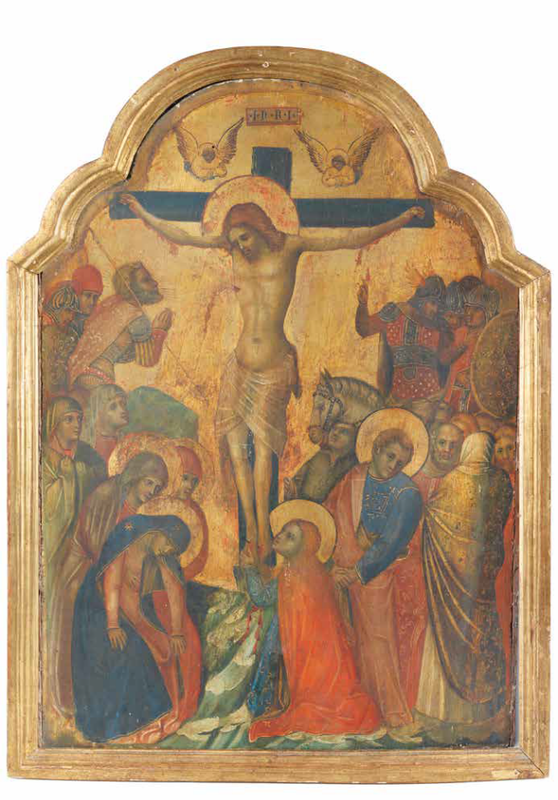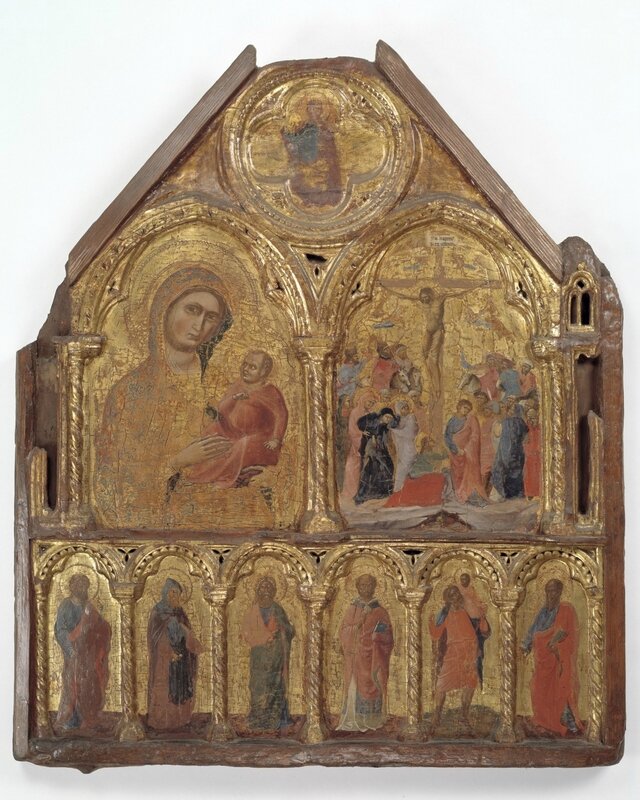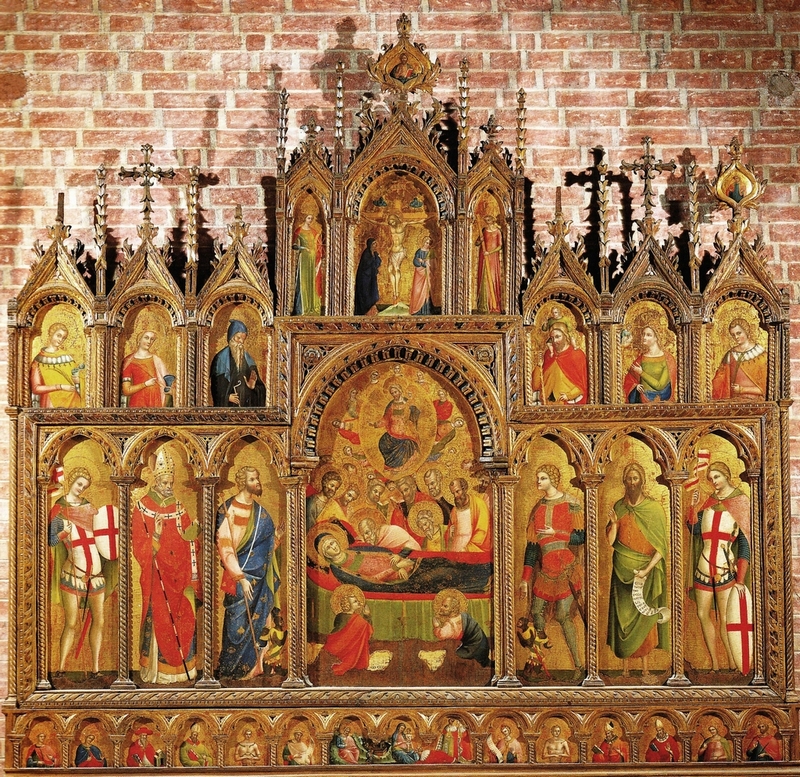Provenance: Baron de Cosson (1846-1929), the British-born antiquarian collector,
acquired circa 1915, and by descent through his family in the U.K. to the present owner.
Note: This splendid newly discovered Crucifixion by Lorenzo Veneziano is a very exciting addition to our knowledge of Venetian painting in the third quarter of the Trecento. A remarkably inventive artist of extraordinary talent, Lorenzo Veneziano was indisputably the leading Venetian painter of the second half of the 14th century and his impact on later Venetian painting was both profound and widespread. He was instrumental in instigating the significant move in Venetian art towards the Gothic style, turning away from those old fashioned Byzantine models that had previously dominated the culture of La Serenissima. Having gathered inspiration from his travels in mainland Italy, his work was in as much demand there as it was in Venice. Lorenzo's influence, moreover, was as diffuse as it was significant: he introduced a naturalism, a fluency of draughtsmanship and a vitality in his figure poses that had never before been seen in Venetian art. All of these elements are emphatically evident in this ornate, colourful and animated panel.
This panel which, since its acquisition a century ago has been the property of the same family, had hitherto remained concealed from the eyes of art historians and had never been published until it was the subject of the recent research conducted by Professor Gaudenz Freuler of Zürich University, whose significant conclusion is shared on the basis of photographs by both Cristina Guarnieri of the Università degli Studi di Padova and Andrea De’ Marchi of the University of Florence. This enables us to place it within Lorenzo’s oeuvre by highlighting a number of similarities to certain other works of his, which Freuler outlines in an article dated October 2017. In this analysis Professor Freuler writes of this “stunning” painting: “Despite its tragic content and its high emotional temperature, the animated scene of the Crucifixion is rendered here with the utmost elegance and finesse amazingly producing an appearance of sophisticated grace and dignity.”
Given its dimensions the Crucifixion could have surmounted a central panel of a large polyptych. Its style is derived from the tradition of the great founder of Venetian 14th century painting, Paolo Veneziano, who was the undisputed leader among Venetian painters of the first half of the 14th century. Paolo's influence is particularly evident if we compare our Crucifixion with the former's interpretation of the subject in the National Gallery in Washington (Kress, fig.1), or that in the Galleria Nazionale in Parma, both painted in relatively early years of Paolo's career, in the fourth decade of the Trecento.
Fig. 1 Paolo Veneziano, The Crucifixion, c. 1340/1345, tempera on panel, 31 x 38 cm, Samuel H. Kress Collection. National Gallery of Art, Washington
In the figure of Christ, for example, we encounter a similarly designed facial expression within finely cut features, together with the wonderfully rendered cloth around Christ's waist, the delicate transparency of which allows Christ's thighs subtly to show through. Equally the highly sophisticated rendering of Christ's body is painted with the most delicate of brushstrokes.
Yet, despite Lorenzo's apparent indebtedness to Paolo Veneziano, the author of our painting clearly employs a more progressive artistic response to his Venetian precursor, based, as it would seem, on the models of Paduan interpretations of the innovations that Giotto introduced to Northern Italy in the first decade of the 14th century, as developed by painters such as Guariento and later Altichiero, whose paintings executed for the Doge's Palace from circa 1408 established the International Gothic style in Venice.
Clear comparisons might be made between the present Crucifixion and such earlier models by Giotto as the panel of the Gemäldegalerie in Berlin (fig.2) or a fragmentary frescoed derivation by a Paduan follower of Giotto in the Museo Nazionale Atestino in Este from which one can recognize the ultimate Giottesque source for our painting. This can be discerned in the compositional conception of the paintings where the figures are similarly arranged as compact groups around the cross; and in certain figures such as the towering figure of the high priest seen from behind lower right, a concept which resurfaces in various paintings conceived by Giotto and his workshop and which was later to be employed by Altichiero in his fresco of the Crucifixion in the church of Sant' Antonio Santo in Padua.
Fig. 2 Giotto di Bondone, The Crucifixion, 1330s, tempera on wood, 58 x 33 cm / © bpk / Gemäldegalerie, SMB / Jörg P. Anders.
At a time when painting in early Trecento Venice was still very much dominated by the conventions of Byzantine art, this distinct awareness of the innovations introduced by Giotto to northern Italian regions, such as Padua and Rimini, was first discernible in the works of Paolo Veneziano, who turned his eyes to Padua and Giotto's artistic concepts. This is apparent in the latter's scenes of the Life of the Virgin in the Pinacoteca Civica in Pesaro, dateable to the third decade of the 14th century. It is probably within this artistic milieu, albeit not necessarily within the workshop of Paolo Veneziano himself, that the author of our impressive Crucifixion must have learnt his art. This is easily discernible with respect to the repertoire of figures with slightly chubby faces and protruding chins, as well as with the distinctive round fierce-looking eyes, together with certain stylistic characteristics, such as the painting of the flesh tones under a dark preparation, or the way in which the hair of his figures is highlighted with white to render them a quality somewhat like cotton wool. These qualities are also distinctive features of the art of the artist who was presumably youngest son of Paolo Veneziano, Marco di Paolo, who signed a Madonna of Humility with donor in the Museum of Western Art in Kiev and whose oeuvre has been convincingly linked by Andrea De Marchi with a group of works surrounding an altarpiece in the church of San Silvestro in Venice.
Such stylistic features resurface in various of Paolo's paintings, such as the little known panel with the Flight into Egypt in a New York collection. This reveals a distinct influence of Lorenzo Veneziano's works painted during the final years of the 1360s. Nevertheless, the author of the present magnificent Crucifixion, in Freuler's view, "goes far beyond the possibilities of Marco di Paolo Veneziano and reveals the artistic concerns of the undisputed protagonist of Venetian painting of this period: Lorenzo Veneziano." Taking all these features into account, Freuler considers the present painting to be "probably one of the most elegant and most fascinating Venetian interpretations of Giotto's older archetypes."
Since the early part of his career Lorenzo expressed in his works an overt awareness of Guariento's Paduan interpretations of Giotto's art. This resulted in a common approach between the two artists in the narrative of their paintings, where, much as with Guariento in his Crucifixion (the central element of a triptych for private devotion in a private collection in Düsseldorf), Lorenzo engaged his active figures in lively communication, illustrating their narratives with a highly emotional intensity. This interest is easily recognised if our Crucifixion is compared to an early interpretation of this subject that features in a sadly damaged small early altarpiece in the Isabella Stewart Gardner Museum in Boston which has recently been assigned to Lorenzo Veneziano's early phase (fig. 3, see Andrea De Marchi, "Una tavola nella Narodna Galeria di Lublijana e una proposta per Marco di Paolo Veneziano", in: Il Gotico in Slovenia, Janez Höfler [ed.], atti del Convegno Internazionale di Studi Ljubljana, Ljubljana 1995, p.244; id., 2005, p. 35-36). Undoubtedly the earlier interpretation of the Crucifixion in Boston appears to be the prototype, to which Lorenzo Veneziano returned some 20 years later in the present painting, where he also repeated the model of his mourning Saint John, who appears here in a more lively and at the same time looser pose. Apparently in Lorenzo's later version he generally moderated the agitated dynamics which are visible in his earlier paintings in favour of a more restrained, if no less dramatic account of Christ's supreme sacrifice, within a more structured composition.
Fig. 3 Lorenzo Veneziano, The Virgin and Child and the Crucifixion with Six Saints, 1300-1350, Tempera on panel, 82.55 x 73.66 cm, Isabella Stewart Gardener Museum.
This freshly discovered panel crucially displays a number of the more modern elements that Lorenzo had come to adopt by the 1360s: as seen, for example, in the painting of the figures which display a more physical presence, coupled with the artist's growing interest in elaborate decoration, as is visible in the ornate garments of the figures and on the soldier's armour. The interaction between the figures has moved away from the earlier, almost violent manner in which Lorenzo had tended to arrange them, so that they now interact in a more subtle fashion, united here in groups: on one side a family in its common grief; on the other a group of sceptics amazed by Christ's sacrifice. This new emotional intensity was Lorenzo Veneziano's great gift to Venetian art. Hence this panel incorporates a number of subtleties worthy of the great artist that he was: such as the imposing figure of the high priest seen from behind and in the foreshortening of his face while conversing with his companions. All these features can be accounted for by Lorenzo's having witnessed those artists on the mainland and in the Po Valley who attempted to refashion the art of Giotto and create more modern artistic solutions.
This same narrative trait was to be further refined in Lorenzo's later panels, depicting the Story of Saint Peter in the Gemäldegalerie in Berlin. Freuler suggests that these panels, which date from circa 1370, indicate the approximate period when our Crucifixion was painted: that is, in the mature period of Lorenzo's brilliant artistic career. It is, however, to a slightly earlier work, the Proti Altarpiece, which is signed and dated 1366, in the cathedral of Vicenza (fig. 4), that our painting reveals the strongest stylistic ties. The artistic relationship is quite evident if we compare the present Crucifixionto that which surmounts the central panel of the Proti Altarpiece - one of Lorenzo's most complete altarpieces which has come down to us. Even though restricted to three main components - Christ on the Cross and the mourning Virgin and John the Evangelist and the two angels hovering above - this concise version of this subject which is bare of all superfluous narrative elements reveals a similar iconographic model. This is particularly evident with regard to the mourning Saint John, who, as in the present painting, is turned to the viewer in order to engage him in his grief; while the attitude of the angels with their arms joined has further parallels in this version. The Saviour on the Cross himself reveals the same form: even though in our version his physical appearance is slightly more slender and elegant, the execution of his body is articulated in both paintings with the same meticulous care and with equally delicate brushstrokes, underlining the artist's capacity to render minute anatomic details to perfection with the tension of the hanging body.
Fig.4. Lorenzo Veneziano, The Proti Altarpiece, 1366, Vicenza Cathedral.
Another technical feature, which betrays Lorenzo's authorship, is the detail of what Freuler terms the sgraffito execution of the mourning angels, which is something that is rarely seen in earlier Venetian Trecento painting and echoes the translucent grisaille angels in his paintings of the Madonna of Humility, in Verona (Sant Anastasia) and Trieste (Santa Maria Maggiore). These concepts were later to inspire the artists of the International Gothic who were active in Lombardy, such a Gentile da Fabriano, and illuminators like the Master of the Franciscan Breviary, for example.
Lorenzo Veneziano's authorship for our Crucifixion might further be endorsed through comparison of the youthful face of our Saint John, slightly inclined towards the left, with two saints of a comparable nature and pose included in Lorenzo's Proti Altarpiece in Vicenza: the Prophet Daniel and Saint Carpoforo, who appear in their anatomical construction as twin brothers of our saint. Lorenzo Veneziano's authorship for our Crucifixion can be yet further established by comparing the profile of Longinus, whose features with its characteristic protruding chin reveal an impressive emotional intensity, with the two mourners in the foreground of the Death and Assumption of the Virgin depicted on the central panel of the Proti Altarpiece. The common hand becomes particularly evident if we consider the face of the elder mourner of the Proti altarpiece, which is slightly turned from full profile – here illustrated in inverted view - back to full profile. Not only is it executed in the same refined manner, but the high emotional intensity resulting from this delicate figural expression corresponds in both paintings.
Taking all our observations into consideration, there remains little doubt about Lorenzo Veneziano's authorship for the present Crucifixion. Not only is this newly discovered painting an astonishing addition to the oeuvre of the most innovative Venetian painter of the 14th century, but it also allows a new insight into Lorenzo Veneziano's artistic direction towards the middle of the 1360s. Maybe due to his continuous contacts with the artistic currents and cross-currents in the Po valley and the north Italian mainland, he returned in this period to reflect anew on the artistic possibilities of Giotto's innovations in the first third of the Trecento. By doing so he temporarily moderated the dynamics of his compositions which were evident in his earlier works, and by incorporating more substantial figures in his compositions he created scenes of greater harmony and less tension. This tendency appears to have been short-lived, since only a few years later Lorenzo was to return to the artistic world which, as early as around 1370 - in, for example, the altarpiece of the Traditio Clavis, Venice, Museo Correr and the panels with the Lives of Saint Peter and Paul in the Gemäldegalerie in Berlin - heralded in Italy the first signs of the movement towards an International Gothic which was further developed at the turn of the century and the following decades by Gentile da Fabriano and other artists in his tradition. This can be illustrated by comparing our mourning Saint John with the youthful Saint Lawrence on one of the lateral panels of Lorenzo Veneziano's 1371 altarpiece with The Annunciation in the Accademia in Venice (fig.5) - one of his most accomplished and most innovative works painted in the final years of his extraordinary career. Freuler thus regards the present Cruxifixion as a new cornerstone in Lorenzo Veneziano's middle period, dateable towards the middle of the seventh decade of the 14th century, probably around 1366-70. It also reveals Lorenzo's ability to adjust his art to the taste of different patrons, as had been accurately observed by Cristina Guarnieri, and his versatility in adopting a variety of artistic trends, fusing them into his own highly personal artistic language (see Cristina Guarnieri, "Le polyptyque pour l'église San Giacomo Maggiore de Bologne dans l'œuvre de Lorenzo Veneziano", in: Autour de Lorenzo Veneziano. Fragments de polyptyques vénetiens du XIV siècle (cat. Tours Musée des Beaux-Arts 22 October 2005- 23 January 2006), Milan 2005, p. 57-79 speciatim p. 68). It is therefore the recent emergence of this crucial work by Lorenzo Veneziano that allows us a far better understanding of a significant period in the artist's eventful career.
Fig. 5 Lorenzo Veneziano (fl. 1356-1372): Polyptych of the Annunciation, 1371. Tempera on panel. 111 x 54 cm (centre). 94 x 24 cm (sides). Venice, Accademia. © 2017. Photo Scala, Florence - courtesy of the Ministero Beni e Att. Culturali e del Turismo
We are grateful to Professor Gaudenz Freuler for his assistance with the catalogue entry for this lot.
Bonhams. OLD MASTER PAINTINGS, 6 Dec 2017, LONDON, NEW BOND STREET

/https%3A%2F%2Fprofilepics.canalblog.com%2Fprofilepics%2F1%2F0%2F100183.jpg)
/https%3A%2F%2Fstorage.canalblog.com%2F03%2F02%2F119589%2F96711876_o.jpg)
/https%3A%2F%2Fstorage.canalblog.com%2F11%2F31%2F119589%2F94773502_o.jpg)
/https%3A%2F%2Fstorage.canalblog.com%2F20%2F83%2F119589%2F94772815_o.jpg)
/https%3A%2F%2Fstorage.canalblog.com%2F26%2F72%2F119589%2F75604929_o.jpg)
/https%3A%2F%2Fstorage.canalblog.com%2F59%2F60%2F119589%2F26458628_o.jpg)









/image%2F1371349%2F20240425%2Fob_c453b7_439605604-1657274835042529-47869416345.jpg)
/image%2F1371349%2F20240425%2Fob_59c6f0_440358655-1657722021664477-71089985267.jpg)
/image%2F1371349%2F20240425%2Fob_07a28e_440353390-1657720444997968-29046181244.jpg)
/image%2F1371349%2F20240425%2Fob_0b83fb_440387817-1657715464998466-20094023921.jpg)